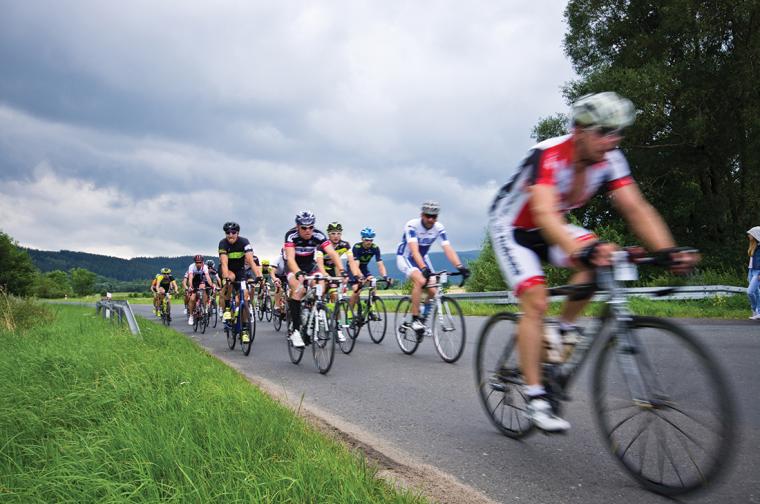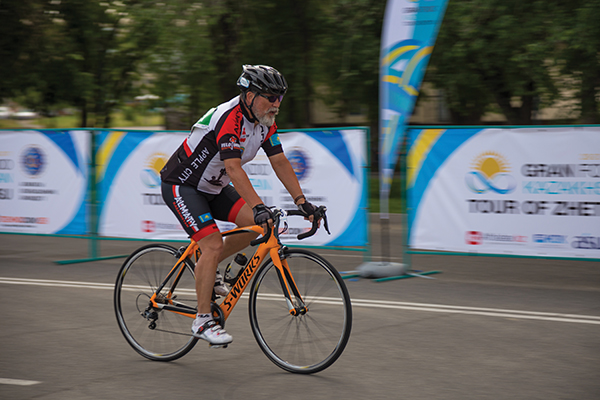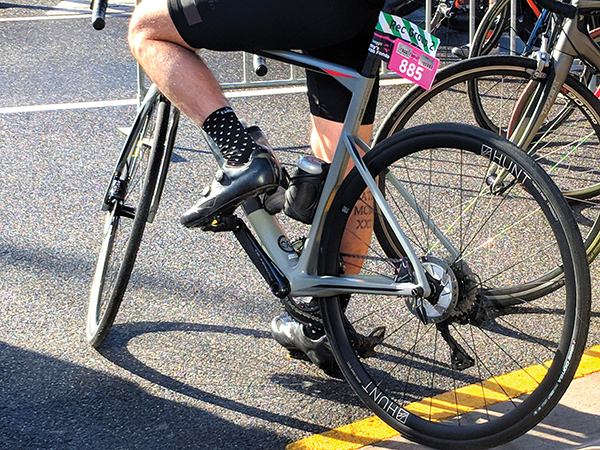
The term, “gran fondo,” translated from its original Italian, means ìBig Ride.î As the cycling discipline recognized today, however, a gran fondo is a type of long-distance road cycling which generally is open to the public and has a larger field than many other events.
The gran fondo is not as intimidating as other races; it does not require cyclists to ride in a pack, or to draft. It is not a multiple-stage race like the Tour de France, and it’s not a criterium (also known as a crit), which consists of several laps around a closed circuit.
This type of cycling event offers something for almost everyone. In the past, cycling wasn’t a user-friendly sport; in other words, there haven’t been opportunities for people to get on their bikes and race in a format that was safe and fun. In our events, we don’t have any start to finish time, so it’s not just about getting through the course as fast as possible.
There are timed segments throughout the ride; the sections are anywhere from two to 10 miles in distance. People can race hard through these sections if they want, but those who don’t can progress along the route in a leisurely fashion with their friends. People can make the ride into whatever they want.
The Gran Fondo National Series (GFNS) is the country’s only national cycling race/ride series. The series was established in 2012 and is comprised of nine European-style ride/races staged in the United States. Every GFNS event offers courses covering 30, 60 and 100-mile journeys through some of the most beautiful and challenging terrain in endurance sports. Participants can ride as individuals or in teams. GFNS awards special prizes to the top riders in every age and gender category.
While there are other event owners in the marketplace, GFNS is currently the only series, and is recognized by USA Cycling as its official gran fondo competition. Its events last one day and offer multiple options for riders of varying skill and endurance levels. Routes are generally 30, 60 and 100 miles long. The majority of cyclists, about 60 percent, take part in the 100-mile event.
Type of Cyclists Competing

Events are open to cyclists of all abilities. Many people are surprised to learn that most of the people who enroll in the GFNS are amateurs, as opposed to professional cyclists. In fact, according to USA Cycling, you are not allowed to be a professional cyclist and compete in the national championship. This year, the National Championship event is hosted in Frederick, Maryland.
The Appeal of the Gran Fondo
In a gran fondo, people do not have to be racing the whole time. There are segments where they can be competitive if they want, but at other points, they can ride with friends, get a drink of water, use the bathroom and so on. Cyclists generally ride out of town at the start, follow the course, and come back into town at the finish, where the atmosphere is almost like a festival, with hot food and cold beer.
It’s the same mindset as a marathon; many people do not sign up with the idea that they are going to win. They might want to have a good finish time, they might just be there for the workout, they might want the feeling of accomplishment and the finisher medal they get at the end. The gran fondo gives them a way to be competitive if they want, but also to enjoy the experience.
The Need for Cycling Events…
We recognized the absence of user-friendly competitive road cycling events, and the absence of cycling events that offered both a recreational and competitive experience where people could challenge themselves at their personal level of cycling. Over the previous decade, we saw the growth of marathons, as well as triathlons and we saw other multi-sport events skyrocket – but there was no tangible growth in competitive cycling. Cycling experienced what I’ll call the Lance Armstrong effect: we saw a lot of people get into cycling, but there was no user-friendly competitive outlet for them to engage in cycling.
…Without Closing Off Streets
When we start in downtown Frederick, we will have a police presence leading out the cyclists; however, once cyclists start, they are headed out of town. We can use a rolling closure for when they leave and again when they return to town, which is when there is food and beer and an award ceremony.
For the longest routes, people could be out riding for six hours, but they are outside of town so there is no need to close streets for that amount of time. We understand that people do not want to be trapped in their neighborhoods all day; they may have to go to the store, take their child to piano lessons and so on. We want this to be a positive experience, not an onerous one, for communities to host. It’s OK to tell people to watch for bikes; it’s not OK to clog up the streets and impede people’s lives. As riders reach the race segment portions of the course, those areas might be closed to traffic to keep people safe, but that is it.
Hosting Communities

You’re looking for a quality cycling experience, a place people would like to ride. You really do not want a place that has a lot of traffic and is really congested. Beyond that, we ask questions like whether it is a compelling destination, whether it can bring a good turnout and whether it will be good for the community to host the event.
You also want support from the community. For example, maybe some of the costs for management, such as traffic control, could be offset by sponsorship from the local tourism department. Maybe there is an organization in the area that is looking for a fundraiser; if so, that can drive awareness and participation.
The GFNS is broken down into events that are owned, and those in which we partner with other organizations. A full listing of those events can be found on our website.
Participation Trends
Participation has declined in competitive cycling events overall but gran fondos have grown because they are different; in fact, we have seen 20 percent growth year over year. Gran fondos offer something to people who want to compete, as well as to those who want to enjoy the experience.
We also see an aging population in cycling, with most people in our events between the ages of 40 and 60. The Millennials are not a big cycling group but the under-25 age group is starting to come in. To help encourage them, we have created a special registration fee: $23 per person if you’re 23 or under.
The gender breakdown of cycling also remains steady; most cycling organizations will say it is about 80 percent male and 20 percent female, but we tend to think having 20 percent of your total registration be women is exceptional.
The Impetus for Developing Gran Fondos
I spent a lot of time as a race director for events like triathlon, and if you look at those athletes, you realize that of course, all those people own bicycles. Also, out of all those athletes, you might have five percent who have never been in a running race like a 5K or a marathon.
On the other hand, you have only five percent who have actually done a bicycle race. Crits and stage races, stated earlier, are intimidating to them. There are a lot of century rides in existence, but century rides do not offer the kind of competitive experience gran fondo offers.
Cycling has been missing a user-friendly competitive outlet for the general public to engage in the sport, and that is why we started the GFNS. Our slogan, “Believe in the bike,” is a statement that captures our philosophy and passion for cycling and we want to share it. SDM
